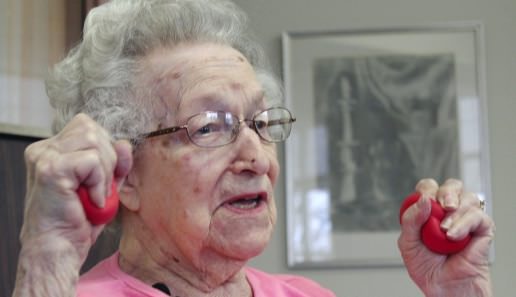The fitness instructor is about to start pushups, but first she has to move her walker out of the way. The exercisers at this apartment complex are all over 75 and their leader, Hildegard Gigl, will turn 99 in June.
“I’m getting older, but I’m not getting old,” said Gigl, whose half-hour class includes pushups against a wall and weightlifting with soup cans to In the Mood and other big band tunes.
Exercise may be the closest thing we have to a fountain of youth, one of the best ways to age happy and well.
“The mantra now is, exercise is a drug” – able, like some medications are, to prevent and treat a host of age-related ailments, said Dr. Andrea Cheville, a Mayo Clinic expert on exercise in the elderly.
Exercise aids weight control, healthy cholesterol, blood pressure, mood and sleep. It lowers the risk for cancer, brittle bones and Alzheimer’s disease. One of the most recent studies found that walking farther or faster after age 65 – increasing activity rather than slowing down in older age – helps maintain a good heart rhythm and prevent heart attacks.
Even conditions like back pain and arthritis, which many people cite as reasons they don’t exercise, often can be helped by doing that very thing.
Senior programs emphasize moves that help people live independently. Wall pushups maintain strength and dexterity to open doors; raising arms behind the head “to imitate zipping your dress or combing your hair” help those with arthritis groom themselves, Cindy McDermott of Y-USA explained.
“What attracts older adults is quality of life. They want to be able to lift their grandchildren,” she said.
The type, frequency and dose of exercise need to be appropriate for someone’s age, health and condition.
If someone has pain, see a doctor to rule out tissue damage from knee pain, or a back problem that could be made worse by exercise.
“Find ways to exercise that don’t exacerbate the pain,” Cheville said. Climbing stairs might hurt, but cycling or water exercise may not. Physical therapy to strengthen certain muscle groups can help, and can even delay a knee or hip replacement for years, she said.
Start light and gradually build up to at least 30 minutes of activity on most days of the week. This could be several 10-minute sessions throughout the day.
Look for opportunities: The Y suggests standing on one foot while brushing your teeth to increase balance, doing squats while washing dishes and taking stretch breaks while watching TV. Take the stairs instead of an elevator or park farther from your destination and walk.
Group exercise classes like the one Gigl leads in suburban Milwaukee also offer a chance to socialize and make friends.
“What’s a wonder is her memory” to move through all the exercises with no notes, one participant, Carole Pape, 85, said. “It’s just enough to move all the parts of your body.”
Agencies/AP/Canadajournal
 Canada Journal – News of the World Articles and videos to bring you the biggest Canadian news stories from across the country every day
Canada Journal – News of the World Articles and videos to bring you the biggest Canadian news stories from across the country every day



